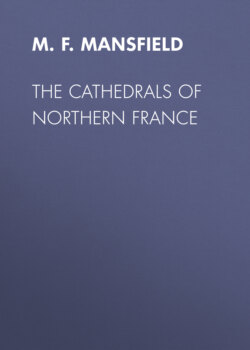Читать книгу The Cathedrals of Northern France - M. F. Mansfield - Страница 7
На сайте Литреса книга снята с продажи.
III
NOTRE DAME DE NOYON
ОглавлениеIn Notre Dame at Noyon, Notre Dame at Laon, and the cathedral at Tournai, is to be noted the very unusual division of the interior elevation into four ranges of openings, this effect being only seen at Paris and Rouen among the large cathedrals. Noyon and Laon borrowed, perhaps, from Tournai, where building was commenced at least a century before either of the French examples first took form. It is perhaps not essential that such an arrangement be made in order to give an effect of loftiness, which might not otherwise exist; indeed, it is a question if the reverse is not actually the case, though the effect is undeniably one of grandeur. Soissons, too, may rightly enough be included in the group, though the points of resemblance in this case are confined to the rising steps to either transept, coupled with the joint possession of circumambient aisles, and at least the suggested intent of circular apsidal terminations to the transepts; though it appears that here this plan was ultimately changed and one transept finished off with the usual rectangular ending.
In this Noyon plainly excels, and there is found nowhere else in France the perfect trefoil effect produced by the apsidal terminations of both transepts and choir. So far as the transepts are concerned, they are of the manner affected by the builders on the Rhine, notably in the Minster at Bonn, at Cologne, and again at Neuss in the neighbourhood of Cologne. With Noyon apparently nothing is lacking either in the perfections of its former cathedral or in its immediate environment. The country round about is thoroughly agricultural, and free from the soot and grime of a manufacturing community. Amid a setting at once historic and romantic, it has for neighbours the chateaux of Coucy and Perrifonds, with Compiègne and Chantilly not far distant. The town is unprogressive enough, and the vast barge traffic of the Oise sidles by, not a mile away, as if it were all unconscious of the existence of any signs of modern civilization. As a matter of fact, it hardly is modern. The accommodation for the weary traveller is of a satisfying and gratifying quality, as the comparatively few visitors to the place well know. The city is an ancient foundation, having been known as the Noviodunum of the Romans. Here Charlemagne was crowned King of the Franks in 768, and Hugh Capet elected king in 987; and here, in an important stronghold of Catholicism, as it had long been, Calvin was born in 1509.
Altogether there is much to be found here to charm and stimulate our imagination. As a type the cathedral stands preëminent. As to detail and state of preservation, they, too, leave little to be desired, though the appreciative author of a charming and valuable work treating of a good half hundred or more of the "architectural glories of France" bemoans the lack of a satisfying daily "Office." This may be a fault, possibly, if such be really the case. The fabric of the church has stood the wear and tear of time and stress exceeding well. Built in the eleventh and twelfth centuries, it is a thoroughly harmonious and pleasing whole, and we can well believe all that may have been said of it by the few able critics who have passed judgment upon its style, as well as the sentiment conveyed by the phrase that it is "one of the most graceful and lovable of all the cathedrals of France." The bishopric was suppressed after the Revolution, and the church is now a dependency of the Bishop of Beauvais.
The elongated belfry towers are perhaps the first and most noticeable feature; secondly, the overhanging porch with its supporting frontal buttresses; thirdly, the before-mentioned tri-apsidal effect of the easterly end; and, last but not least, the general grouping of the whole structure in combination with the buildings which are gathered about its haunches, though with no suspicion of a detracting element as in some sordid and crowded cities, where, in spite of undeniable picturesqueness, is presented a squalor and poverty not creditable either to the city of its habitation or to the cathedral authorities themselves. From every point of vantage the steeples of Notre Dame de Noyon add the one ingredient which makes a unity of the entire ensemble—a true old-world atmosphere, a town seen in not too apparent a state of unrepair and certainly not a degenerate.
The interior presents no less striking or noble features. It is not stupendous or remarkably awesome; but it is grand, with a subtleness which is inexpressible. Round and pointed arches are intermixed, and there is a notable display of the round variety in the upper ranges of the quadrupled elevation of the nave, the lightness, which might otherwise have been marred, being preserved through the employment of a series of simple lancets in the clerestory of the choir. Rearward of the south transept are the chapter-house and the scanty remains of a Gothic cloister, where a somewhat careworn combination of the forces of nature and art have culminated in giving an unusually old-world charm to this apparently neglected gem, as well representative of early French Gothic as any in existence to-day.
